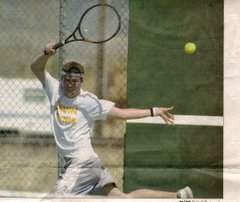The Comeback Queens
The US Open always makes me nostalgic. Every year brings its thrilling matches (though fewer this year than others) along with plenty of drama and sometimes - if we're lucky - outright cattiness.
Back in 1995, when I was just 9 years old, I remember sitting in front of our TV at home in Montana watching Monica Seles, dressed in a plaid skirt with a tight-pulled ponytail, belting balls back and forth with world number one Steffi Graf.
Seles had just returned from over two years off the tour following the horrific stabbing in Hamburg, Germany in April of 1993. She had gone through rounds of physical battles over the 27 months, but it was the mental climb (helped in part by her attacker being sentenced to absolutely no time in jail) that took her the longest to make.
When Seles came back, however, she was the darling of the tennis tour. Over the next eight year, Monica would show us flashes of brilliance that she demonstrated in the early 90s. She was the original Comeback Queen.
Six years after Seles' triumphant return, Jennifer Capriati made a run at the Australian Open that shook the tennis world to the core. Since her Slam debut at the 1990 French Open (at age 14), JCap had been christened the darling (and future) of tennis.  (Capriati at Wimbledon in 1989, just months after turning pro and still a tennis princess. Photo by jacdupree via flickr.)
(Capriati at Wimbledon in 1989, just months after turning pro and still a tennis princess. Photo by jacdupree via flickr.)
Yet the child prodigy from Florida would fizzle instead of flourish, falling off the map in 1994 after less-than-hoped-for results on the tour. In 2001, technically five years into her 'comeback', Capriati re-committed herself to the game she had played since a toddler and won her first Grand Slam ten long years after everyone thought she would.
Martina Hingis was much like Seles and Capriati: a teen upstart with an sassy attitude and the game to match. In 1997, the then 16 year old won three of the four Majors and was the number one player in the world. Five years later she was a bitter middleweight, and left the tour due to 'foot problems'.
Though Hingis was driven away not by a knife or the lure of normalcy, the same call that Seles and Capriati heard beckoned the Swiss Miss back to the WTA in 2006, where she made a triumphant return into the Top 10.
Though Hingis has not produced a Slam in her second go as a pro, the verdict is still out on whether or not she indeed can be christened a Comeback Queen. As is the verdict on Lindsay Davenport, who is just one tournament (in singles) and a handful matches into her trial as touring mother.
Davenport's comeback comes under much different circumstnces than the three former teen queens, yet the goal is the same: win a Slam and get back to the top of the game. The Californian's strokes have always been some of the cleanest and most effective on tour, but will her once-scrutinized limited movement become a liability again?
It's hard to tell so soon, but it's easy to see that Davenport would like to join the distinguished of both the past (the aforementioned Queens) and the present (Henin, Williams and co.). Does she have what it takes?
If becoming a mom can teach Davenport one thing, perhaps it is how to handle her mood swings on the court. For much of her career, the American struggled with negativity on the court. With slumping shoulders and a moping attitude, Davenport lost many matches that - if she had the fighting spirit of a Serena Williams - she might have been able to have pulled out.
So if Jagger has taught Lindsay any lessons yet, they might give his mom an idea of how to become a Comeback Queen.

1 comment:
everytime i go to the wta website and see the thing on daniela, i think it says 'hantuchova blogs from hell'
Post a Comment